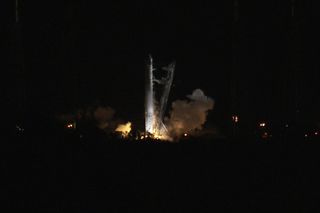SpaceX Launch Abort Traced to Faulty Rocket Valve

This story was updated at 6:15 p.m. EDT.
CAPE CANAVERAL, Fla. — A failed rocket engine valve appears to be responsible for the unexpected abort of a private SpaceX rocket launch before dawn on Saturday (May 19), officials said.
SpaceX was slated to blast off its unmanned Dragon capsule and Falcon 9 rocket at 4:55 a.m. EDT (0855 GMT) here at the Cape Canaveral Air Force Station. Just after igniting its main engines, the computer onboard the booster initiated an automatic abort due to a high pressure reading in one of the rocket's nine main engines.
Dragon was due to fly to the International Space Station to become the first non-governmental vehicle to berth there. The spacecraft's next chance to launch is Tuesday (May 22) at 3:44 a.m. EDT (0744 GMT), followed by a potential opportunity Wednesday (May 23) at 3:22 a.m. EDT (0722 GMT).
This afternoon SpaceX engineers examined the rocket, and traced the problem back to the check valve on the Falcon 9's fifth Merlin engine (the booster has a total of nine).
"We have discovered root cause and repairs are underway," SpaceX officials said in a statement Saturday evening.
Technicians are now working to replace the failed valve for a second try at launch.
Get the Space.com Newsletter
Breaking space news, the latest updates on rocket launches, skywatching events and more!
"Those repairs should be complete tonight," officials said. "We will continue to review data on Sunday. If things look good, we will be ready to attempt to launch on Tuesday, May 22nd at 3:44 AM Eastern."
The flight is a trial run for SpaceX's plan to deliver cargo, and eventually crew, to the space station. The mission is partially funded by NASA's COTS (Commercial Orbital Transportation Services) program, and the firm has a NASA contract to fly 12 delivery missions to the outpost once test flights are completed.
"We're ready to support when SpaceX is ready to go," Alan Lindenmoyer, manager of NASA's commercial crew and cargo program, said during a news briefing following the launch attempt.
Officials from both NASA and SpaceX have emphasized the uncertain nature of test flights, and said that the main goal was to gather more data about the vehicle.
"This is not a failure," SpaceX president Gwynne Shotwell said. "We aborted with purpose. It would have been a failure if we had lifted off with an engine trending in this direction."
You can follow SPACE.com assistant managing editor Clara Moskowitz on Twitter @ClaraMoskowitz. Follow SPACE.com for the latest in space science and exploration news on Twitter @Spacedotcom and on Facebook.
Join our Space Forums to keep talking space on the latest missions, night sky and more! And if you have a news tip, correction or comment, let us know at: community@space.com.

Clara Moskowitz is a science and space writer who joined the Space.com team in 2008 and served as Assistant Managing Editor from 2011 to 2013. Clara has a bachelor's degree in astronomy and physics from Wesleyan University, and a graduate certificate in science writing from the University of California, Santa Cruz. She covers everything from astronomy to human spaceflight and once aced a NASTAR suborbital spaceflight training program for space missions. Clara is currently Associate Editor of Scientific American. To see her latest project is, follow Clara on Twitter.
